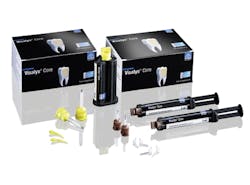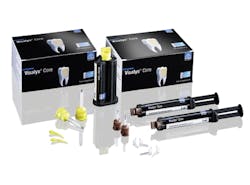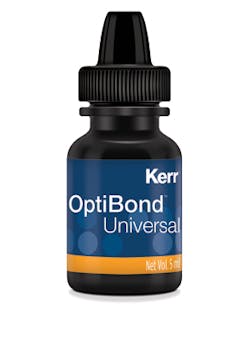Visalys Core by Kettenbach
I am fortunate to talk to a lot of general and restorative dentists around the United States when I lecture. Lectures work both ways. It isn’t just me giving out information; I learn just as much, if not more, from the attendees. I enjoy hearing about what is working well for other docs and expanding my horizons. Core buildups seem to be an area where I diverge from the typical general practitioner, and I have good reasons for that.
With the emergence of monolithic all-ceramic crowns, we need preps that have rounded inner edges and simple external form. This will keep our restorations from cracking. Because of that, I tend to do a lot of core buildups. I want my preps to be as close to ideal as possible, and core buildups are an important tool for that.
The typical general dentist I talk to uses resin composite for buildup material. No surprise there, right? What else is there—amalgam? What I mean to say is that the average general dentist uses the same composite for direct restorations and core buildups. They might use a paste or a flowable depending on size or access, but they aren’t using a specialized core buildup material. I think that is a mistake.
Resin composite is expensive. The leading flowable resin composite runs over $20 per milliliter. That adds up. Cost is one of several specific reasons why I use a dual-cure core buildup material. Visalys Core by Kettenbach is one of my go-to materials for core buildups. It offers a combination of handling, esthetics, and value.
Visalys Core is a dual-cure, radiopaque composite resin that is ideal for core buildups and post cementation. When dealing with large deep areas that need building up, using a dual-cure material is a must. Visalys Core’s Active-Connect-Technology ensures a reliable bond with most common adhesive systems, meaning no catalysts are needed. It is BPA free, which is great for those of us with patients who ask those sorts of questions. It handles and cuts well, and it gives me a void-free buildup that preps like tooth.
Esthetically, Visalys Core gives me only the choices I need: white (which is a high-value bright white) and dentin. White works well for posterior teeth and lets me easily see when I am prepping on buildup or on natural tooth. With some materials it can be difficult to tell, especially interproximally, so there is a risk of leaving a prep on buildup. Dentin works well for anterior teeth and won’t make a choice for the ceramist to block out.
Visalys Core is under $8 per milliliter—a substantial savings compared to flowable composite. If you are using regular composite for your buildups, look at adding Visalys Core. It will save you time and money while giving you great results. Opposite-field double into the corner for Visalys Core!
OptiBond Universal adhesive by Kerr
It has been several years since I began writing this column for Dental Economics. I have loved every minute of this journey. Part of what has made this such a great experience is that this is a tremendous time in dentistry. Digital dentistry is mainstream. Information is more easily distributed than ever before. Dental materials are improving rapidly.
In this time, there have been three main trends in dental materials: bulk-fill composite materials, materials that have a bioactive component, and universal adhesives. We have seen adhesives evolve to simplify our procedures and practices. In my experience, simplicity is priceless.
Even the most tried and true fourth-generation adhesive brand names have gone universal. OptiBond Universal is the next in line. OptiBond FL stands as an industry leader in the world of fourth-generation adhesives, and it has served as the standard for a great bonding agent. That DNA lives on in OptiBond Universal.
What makes universal adhesives so appealing is their wide range of uses. With a single bottle, a dentist can bond to enamel, dentin, glass ceramics, zirconia, and metal. Universals can be used for direct and indirect restorations, eliminating the need for multiple bottles of expensive products. Universal adhesives also allow for self-etch, selective-etch, and total-etch methods. You can use universal adhesives your way.
OptiBond Universal is an excellent choice for your universal adhesive. Its GPDM (glycero-phosphate dimethacrylate) monomer provides effective and reliable adhesion and more functional groups for bonding than the MDP (10-methacryloyloxydecyl dihydrogen phosphate) monomer. This means it has better compatibility with substrates and a higher bond strength.
Another novel property of OptiBond Universal is the ternary solvent system, which gives it a more reliable and less technique-sensitive bond. Most adhesives have just one solvent, but OptiBond Universal has three, each with its own advantage. Water, acetone, and ethanol work together effectively to etch the enamel and dentin and prime and seal the dentin. Really cool stuff!
For me, universal adhesives offer freedom—freedom in etch techniques, freedom in different applications, and freedom from stocking multiple products that essentially do the same thing to different materials. This makes me more efficient and more economic. Triple over the center fielder’s head for Kerr on OptiBond Universal!
iTero Element 2 intraoral scanner with TimeLapse
We often fly blindly as dentists. It’s not really our fault—it is just what we have had to do, given the limitations of the technology we have always had in our profession. When we see something that we think could turn into an issue, we watch it. We watch many issues become bigger problems. Why do we do that? Partially because we have had to rely on our eyes so much.
The problem is that we have so many patients that we see between visits. Here’s a scenario that has played out in my office:
Me: Wow, that wear on Nos. 30 and 31 looks significant. We should watch that.
Hygienist: OK, noted.
Six months later . . .
Hygienist: We are watching Nos. 30 and 31 for wear.
Me, based on zero evidence: Umm, OK, I think they kind of look the same. We should be good. Keep watching.
During the six months between those appointments, much has happened. I have slept a few times. I have seen about a thousand other patients. There is no possible way for me to remember what kind of wear was there before, compared to the wear now. Even if I had photographs, it’s unlikely that they would show 100 microns of wear. We’ve always needed a way to quantify the wear and recession that we watch. That is where TimeLapse comes in.
TimeLapse is a feature on the iTero Element 2 intraoral scanner that can give patients visual demonstrations of what is happening in their mouths, making any issues easier to discuss. This all sounds like a great benefit for the patient, and it is. But it is also a tremendous benefit for us. Finally, I can have some unequivocal evidence to help me make clinical judgments and recommendations.
TimeLapse takes two scans acquired at two different times and lays them over each other. Areas where the tooth structure or gingival margin has changed will light up in yellow or red, depending on the severity. The visual is striking. Finally, I can tell a patient, “You have worn 40 microns off of this cusp,” or “Your gums have receded by 0.65 mm here.”
That type of data helps us create treatment plans. It also helps us get patients to say yes to treatment. I think we can all agree that visualizations and technology help patients understand the need for treatment.
In my practice, we use our iTero Element 2 scanner in the hygiene rooms all the time. Every new patient gets scanned. Patients with wear and recession get scanned yearly or twice yearly. Utilizing TimeLapse in my practice has led to better conversations with my patients—informed conversations with less ambiguity and more directives. Those conversations have led to better educated patients. Better-educated patients lead to more production. More production leads to a happier Josh. Triple into deep center for iTero and the TimeLapse feature!
About the Author
Joshua Austin, DDS, MAGD
Joshua Austin, DDS, MAGD, is a graduate and former faculty member of the University of Texas Health Science Center at San Antonio School of Dentistry. Author of Dental Economics’ Pearls for Your Practice column, Dr. Austin lectures nationally on products, dental technology, online reputation management, and social media. He maintains a full-time restorative dentistry private practice in San Antonio, Texas. You may contact Dr. Austin at [email protected].
Updated June 21, 2023




